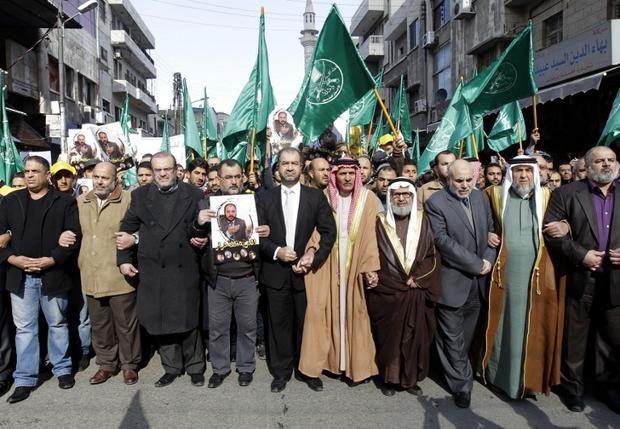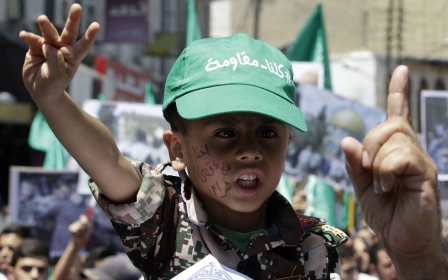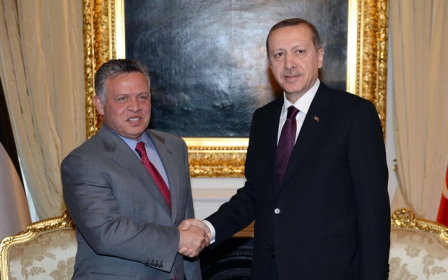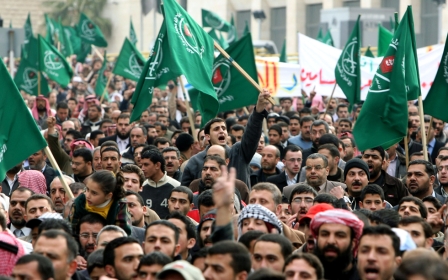Jordan's strategy to fragment the Muslim Brotherhood

The closure of the Jordanian Muslim Brotherhood’s headquarters on 13 April 2016, in addition to the closure of six other Brotherhood chapters in Irbid, Ramtha, Mafraq, Madaba and Karak, constitutes a new phase in the process of fragmenting the group.
This is a method the government has pursued since the Arab Spring. It's a patient strategy, set midway between integration and exclusion. Jordan did not follow the Egyptian, Saudi and UAE model of designating it a terrorist movement and attempting to eradicate it. Nor did it go down the Moroccan path of integrating the group and engaging with it politically.
The Jordanian approach was gradualist. It attacked the group with a series of political and legal measures, creating different currents within the group, polarising it and forcing the doves to assimilate with the policies of the government. These policies led to the birth of the Zamzam initiative, and the licensing of one part of the Brotherhood as a prelude to stripping the historic other part of its legal rights and legitimacy. It also prompted the moves of the so-called “wise men” to advance initiatives which met the government half way.
However, the historic group did not take the government measures seriously and opted to remain steadfast without coming up with any initiatives that might have halted the process of fragmentation. Its decisions to repair the damage in the relationship between the group and the government always came late, such as its decision to terminate its relationship with the Global Guidance Office.
No one disputes the fact that the Muslim Brotherhood in Jordan has been going through an unprecedented crisis both internally with its ideology and organisation and externally in managing its relationship with a semi-authoritarian political regime.
Undoubtedly, the group’s crisis cannot be separated from the crisis of the mother organisation in Egypt and its chapters extending across the region and around the world. Following a brief Brotherhood spring, during which the group accomplished impressive election results that enabled it to rule for a brief period of time in the wake of the Arab Spring revolutions that were launched in early 2011, the group was toppled in a military coup in mid-2013. Soon, the Brotherhood lost its historical gains and ended up in a state of siege and under pursuit locally, regionally and internationally.
The Brotherhood’s international organisation was first designated terrorist in Egypt, the birth place of the group, and then in some Gulf countries led by Saudi Arabia.
Then came the British government’s statements that the Brotherhood had potentially extremist tendencies and finally the vote by the US Congress House Judiciary Committee for the group to be added to the list of terrorist organisations, pending approval by the Secretary of State John Kerry.
The Muslim Brotherhood in Jordan has not met the fate of the mother organisation in Egypt for several reasons. The first reason is the modesty of the demands made by the protest movement in general and the Muslim Brotherhood in particular. The activities were confined to appealing for political and economic reforms without coming close to demanding a regime change.
Movement on back foot
The Hashemite regime enjoys a form of immunity bestowed by its constitution, geography and a relatively relaxed attitude between the government and the opposition. The regime dealt with the protest movement with flexibility. As the government authority remained steadfast while the protest movement retreated, the Muslim Brotherhood fell into a state of weakness, decline and division, lacking the ability to come up with initiatives or make compromises; it became hostage of its own ideological and organisational crisis, which became further augmented as a result of its objective crisis with the semi-authoritarian political regime.
The patient government strategy in dealing with the protest movement bought it time while waiting to see the outcome of the internal demographic protest dynamic and the reactions of the geographically external revolutions. The government introduced political and economic reforms commensurate with the intensity, activism, inclinations, spread and composition of the protests. Most of these protests remained confined to Jordanians from the east of the country.. The majority of the Palestinian population was content to stand on the sidelines as observers.
The Muslim Brotherhood, by virtue of its trans-national religious and political composition, could not surpass its global identity and build a collective Jordanian national identity. This led to an internal debate about the group’s identity and about its priorities and objectives.
By 2013, the peaceful popular Arab revolutions were aborted in the face of a series of counter revolutions that pursued highly complex strategies and tactics aimed at bringing back authoritarian solutions. This happened with the military coup in Egypt, the militarisation of the revolution in Syria, and the combination of militarisation and civil wars in Libya and Yemen. Morocco managed to get through by means of the processes of politically integrating moderation while Tunisia entered cautiously into a process of democratic transformation.
Over several decades, the Muslim Brotherhood group, as a semi-political movement, constituted a challenge for the regimes that emerged in the wake of the colonial authoritarian or semi-authoritarian era in the region. The relationship between the Arab national regimes, with its hybrid authoritarian and semi-authoritarian nature, and the Muslim Brotherhood, with its hybrid political and religious nature, oscillated between embrace and alliance at times and hostility and eradication at other times. But it was never a true partner in power. In the wake of the era of the Arab revolutionary uprisings, the relationship became even more tense and conflictual.
Eradication or containment
At the time when the Egyptian regime and some of the Gulf countries such as Saudi Arabia and the United Arab Emirate adopted the method of eradication, Morocco adopted the method of integration. In the meantime Jordan adopted a different approach based on the comprehensiveness of partial containment of moderation and the selectivity outlawing, security-based fragmentation and the gradual removal of legal legitimacy.
Integration, containment, eradication and exclusion have all been tried by different regimes at different times. Nasser’s Egypt used the more radical and extreme method. In contrast, the policies adopted by the semi-authoritarian regimes of Sadat and Mubarak produced a more pragmatic and moderate reformist approach.
The Brotherhood, too, oscillated between two methodologies; one of them was about identity and religious revivalism while the other was moral, pragmatic and political. This was due to the imperfection of the democratic transformation paths of the group and the regime and the contradiction between their visions about the state, society, Islam and modernity. As such, it would seem that the strategy of the group, as a semi political movement, and of the regime, as a semi authoritarian power, both lead to conflict, as each party endeavours to invest in the objective circumstances in order to weaken the other and then jump over it and bring it down, the movement by means of ideological mass mobilisation and the regime by means of bureaucratic and repressive agencies.
The crisis of the Muslim Brotherhood group in Jordan progressed since Jordan joined the paths of the third democratic transformation wave that swept across the Arab world at the end of the cold war. Jordan became a state of restricted democracy that led to the founding of licensed political parties and a measured election process that did not result in a radical change in participation in political decision-making. This involved the adoption of limited reforms that did not impact on the essence of the political system.
Yet, this shift to a hybrid condition of democracy and authoritarianism was decisive in changing the nature of the relationship between Brotherhood and the regime. The transformation into a semi-authoritarian regime pushed the group increasingly to change from a religious revivalist movement to a semi-political movement. Despite the significant gains accomplished within the semi-authoritarian context, both the regime and the group realised the rules of the game. Accordingly, the group could participate in the elections but not win them.
When the Arab Spring protests took root in Jordan in early 2011, the Brotherhood’s sensed a new era of hope. It increased its demands for reforming the political system and for democratic transition to a real participatory democracy without coming near demanding a regime change. However, the dynamic of the democratic transition process and power sharing that started in 1989 posed challenges to both the group and the regime. These challenges were on the question of integration. Was the group moderate enough to be including in the political system?
Hawks and doves
Moderation was however a subjective concept and debate about it polarised and divided the group. The gap grew between the regime and the reformist and conservative trends on the issue of how the Brotherhood should be managed.
In the 1990s, the terms hawks and doves within the group referred to the different ideological and radical reform trends inside the internal intellectual and jurisprudential structures of the group. However, more recently it referred mostly to the nature of interaction with the political system and managing the relationship as a political opposition movement that is between the ideological and the pragmatic approaches.
Engaging in political action within a semi-authoritarian political environment immersed the Muslim Brotherhood group in a state of anxiety, internal tension, division and strife. The regime’s policies demand more political participation from it and no boycott. However, it does not guarantee the observance of fair measures in attaining democratic results. Hence the dispute between the radicals and the moderates over the viability of the political process and the limits of moderation and radicalism.
According to Nathan Brown: “The Islamic movements will seek unconfirmed benefits by effecting uncertain changes. They mould their organisations and twist their ideologies. Yet, they are cautious vis-à-vis the likelihood of the inadequacy or failure of the political openness to achieve their aspirations.”
Fragmenting the Muslim Brotherhood in Jordan is the Jordanian method of dealing with political Islam. The strategy will soon be expanded to include the group's political arm, the Islamic Action Front Party. The aim would be to create more divisions, at times on the basis of identity and at times on the basis of politics.
- Hassan Abu Haniyeh is a Jordanian researcher. This article originally appeared in Arabic at the website Arabi21.com.
The views expressed in this article belong to the author and do not necessarily reflect the editorial policy of Middle East Eye.
Image: Leaders of the Muslim Brotherhood in Jordan lead a demonstration in Amman in November 2014 (AFP)
New MEE newsletter: Jerusalem Dispatch
Sign up to get the latest insights and analysis on Israel-Palestine, alongside Turkey Unpacked and other MEE newsletters
Middle East Eye delivers independent and unrivalled coverage and analysis of the Middle East, North Africa and beyond. To learn more about republishing this content and the associated fees, please fill out this form. More about MEE can be found here.





